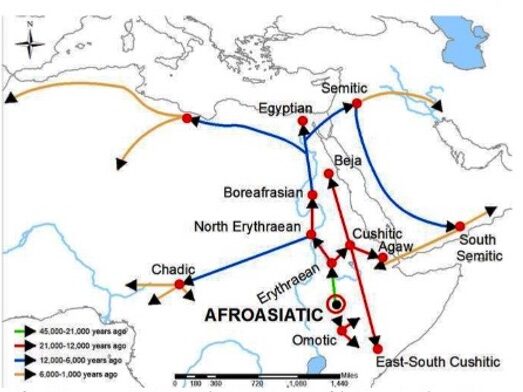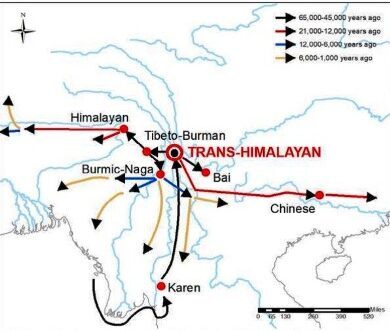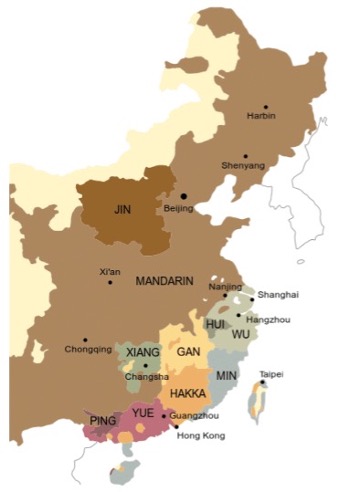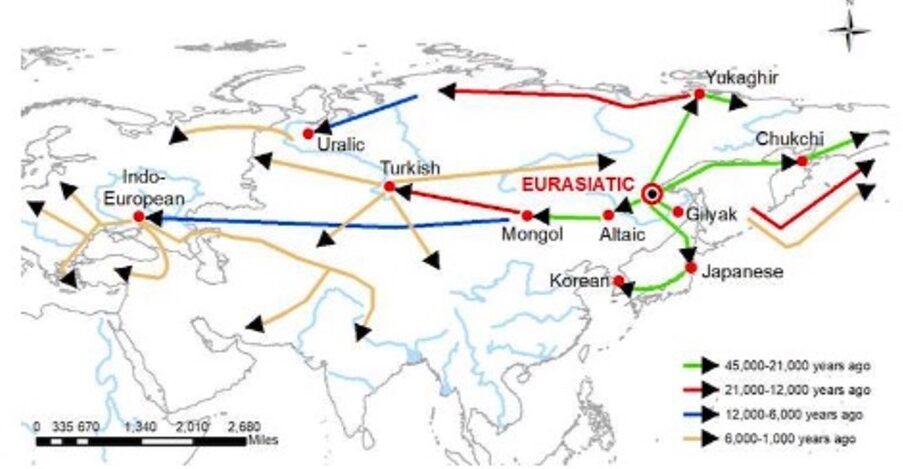Linguistics is a precious but underutilized tool for the study of the human past. Linguistics explores the words and grammar of individual languages; it also explores the distribution of languages in space and time, showing how people and their languages have migrated in association with social change. As a reminder of the value and the practical usability of language evidence for human history, here is a set of four case studies of the distribution and migration of language communities and the associated social change.
Algonkian Speakers Remake the Map of North American Languages
A remarkable example of language migration and change is that of the Algonkian languages, widely spoken in North America. The Algic-speaking ancestors of Algonkian lived on the plateau of the Columbia and Snake Rivers, where their descendants are now known as Blackfoot (Map 1). By 4,000 years ago, these Algic-speakers developed a rich culture that included salmon fishing, ceremonies involving red ochre coloring, and burial in mounds created by glaciers. Then many of them migrated eastward in a group—perhaps driven from their homeland by invaders.

The migrants settled in areas near Lake Michigan, establishing a new homeland for their culture in subgroups such as the Menominee from 1800 to 1400 BCE. With time, the Algonkian culture of exchange became popular among neighboring groups, so that the Algonkian language spread to the whole Great Lakes area and then north into forests of Central Canada.
Facilitated by travel on waterways, small numbers of settlers brought with them their language and culture, which gained such prestige that whole populations adopted the new language. A look at the great watersheds of North America shows how migration could be encouraged (Map 2). The juncture of the Mississippi watershed and the Great Lakes watershed, with good portages between the two basins (as at Portage, Wisconsin), enabled Algonkian-speakers to spread widely from their Wisconsin homeland. Another portage led from Lake Superior to Lake Winnipeg.

The distribution of central Algonkian languages (light shading in Map 1) is remarkably similar to the combined watersheds of the Great Lakes, the Upper Mississippi, and Lake Winnipeg. It also fits the distribution of Betula papyrifera, the paper birch tree, which became central to canoe manufacture. So it seems likely that the Algonkians developed new and light-weight birchbark canoes, and their language spread with rise in commerce, as birchbark canoes competed with previous dugout canoes.
Later on, Algonkian-speakers settled on the Atlantic coast, after which peoples all along the Atlantic adopted Algonkian languages. (Far to the west, another migration created the Cheyenne.) Each of these migrations took place in the time from 4,000 to 2,000 years ago—more than 10,000 years after humans first settled the Americas.
Parallel stories of language migration and change can be told for many parts of the world. As a result, language change provides a good way to tell stories in world history. Map 3 shows the 14 phyla or families of world languages, noting the estimated geographic region at which each originated. These independent groupings have been clarified during the past two centuries by the work of linguists, most notably Joseph H. Greenberg (1915–2001).

The phyla are numbered in approximate chronological order of their formation, so that their sequence gives an indication of the migration of language groups from Africa to the Americas from 60,000 years ago to 15,000 years ago. From these homelands, migrants carried each language family to fill in every livable space. Later migrations of people and languages—such as that of the Algonkians—covered the tracks of the earlier movements. The distribution of language groups shows that humans migrated everywhere on Earth, not always for the same reasons. Here we will see some differences in stories of migration. (See more information on the world’s watersheds and great rivers, which facilitated these migrations.)
As People Migrated, Languages Migrated Even More
The remaining three cases of language migration draw from Afroasiatic languages of Africa and Southwest Asia, the Chinese languages, and Eurasiatic languages. (The materials for these cases are available at the Language Distribution Worldwide Dataverse and include summaries of language groups and subgroups, maps of their movement over time, and narratives of their migration and the subgroups of languages in each phylum.)

Afroasiatic languages originated in the middle Nile Valley, as shown on Map 4. This is a well-watered region. But the later migrations were to normally dry areas and took place during times of unusual humidity. During times shown by the blue arrows (Map 4), groups of migrants developed agriculture as they carried this language group to the west (modern Chad and Nigeria), to the north (Egypt), to the northeast (the Levant and Arabia), to the northwest (North Africa and the Sahara)—and from Arabia to modern Ethiopia. Afroasiatic languages are spoken today by people of widely different colors and cultures.
Chinese languages began as a subgroup of Trans-Himalayan languages (shown on Map 5), a group that took form more than 45,000 years ago in the Yunnan highlands of the great rivers of Southeast Asia, including the Salween, Mekong, and Yangtze. In these highlands, populations developed different languages—groups of Bai, Tibeto-Burman, and Chinese languages. From 21,000 to 12,000 years ago, Chinese languages moved eastward and downhill, along the Pearl River valley.


Various Chinese language groups developed and moved to the east and north after 12,000 years ago,eventually in farming communities along the Pearl River and then up the coast to what is now Shanghai (Map 6). Two more groups of settlers moved further north. The most successful, known today as Mandarin, spread through the Yellow River Valley, where it became the core of a set of dense populations and large-scale states that spread in multiple directions—south, west, and, at last, north—in later centuries.
Eurasiatic languages formed in the period from 45,000 to 20,000 years ago, as migrants from the west settled in the Amur River Valley (Map 7). Gilyak languages, a small population, formed and remained near the initial point of settlement. The expansion of Eurasiatic speakers in all directions may have owed much to the invention of watertight canoes made of skins sewed and stretched around wooden frames, light and effective in a cold climate. The grouping of Japanese-Korean-Ainu languages moved into regions to the south. Chukchi languages formed to the northeast in the extreme tip of Siberia.
Yukaghir-speakers moved to the north, to the edge of the Arctic Ocean; they domesticated reindeer and gradually moved west, settling in Finland and beyond. Speakers of Altaic languages moved to the west at perhaps 20,000 years ago. (Map 1 shows the great river valleys and watersheds of Siberia that they traveled.) Westward-moving Altaic speakers moved by canoe across portages from watershed to watershed, all the way to Europe. In the dry steppes to the south of the forested river valleys, speakers of Altaic and (later) Indo-European languages hunted mammoths and horses. They eventually domesticated horses for drayage and for warfare, as early at 2500 BCE. First in chariots with light, spoked wheels and later with mounted cavalry, they conquered and settled widely.
Two groups of Eurasiatic languages—Turkish in west Central Asia and Indo-European in nearby Ukraine—produced warriors who fought across all the grasslands of Eurasia, invading China, India, Egypt, and Europe. Turkish and especially Indo-European languages came to dominate all of western Eurasia by 1000 CE. Since 1500, Indo-European languages of Europe have spread to every continent in a complex set of migrations.

Language’s Reflection of Social Complexity
The language patterns of today result partly from migration and partly from cultural change. Migrants followed paths on land in dry and wet times, along rivers and across oceans. Migrants followed animals, plants, minerals; they pursued the technology of archery, boats and chariots; they carried the culture of rituals.
Afroasiatic expansion—both migration and language change—came at a time of unusual rainfall. Chinese languages similarly expanded both before and during the rise of agriculture. Groups such as the Algonkians, spreading widely, overlaid the previous language groups; hints and traditions of the previous groups may still remain. The spread of Indo-European languages into Europe and South Asia, replacing previous languages, came after the rise of agriculture. (The patriarchal family system seems to have brought much cultural change as well.) And the worldwide spread of Indo-European languages after 1500, partly migration, was mostly complex cultural change—including conquest (Map 7).
In sum, to explore world history, it helps to learn the world’s watersheds and language groups, which provide clues into patterns of social change.
Map 7 seems to have a lot of the languages originating in the East and a fair amount of flow spreading westward. Could the westward flow be in response to the end of the Pleistocene and the withdrawal of the glaciers? The suggestion that many of the migrations of language (and people) occurred in times of unusually high rainfall. suggesting that agriculture was an important feature of people’s lives.
What was it about the Algonkian languages allowed them to spread into distinct populations? I would think their technology must have been an advancement over most other cultural groupings.
Thank you for bringing this interesting historical perspective to my attention.